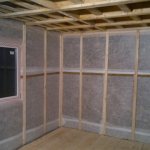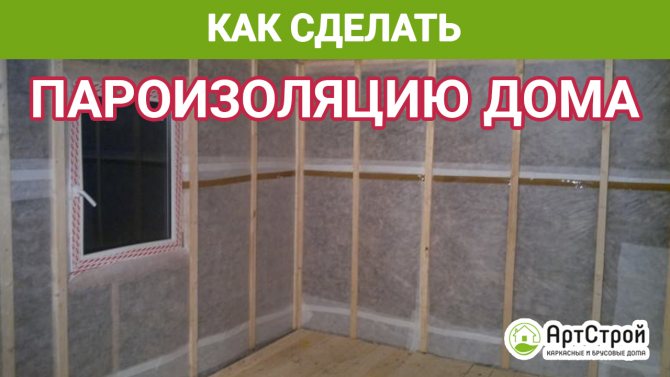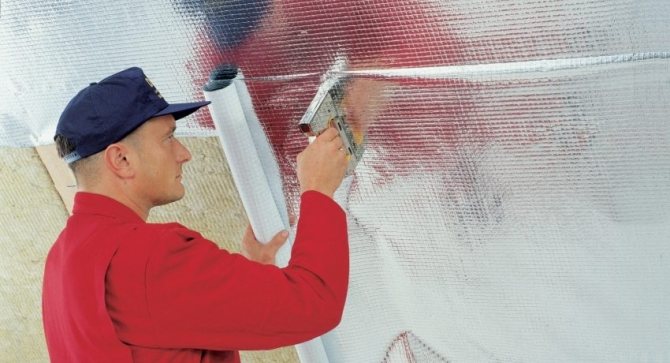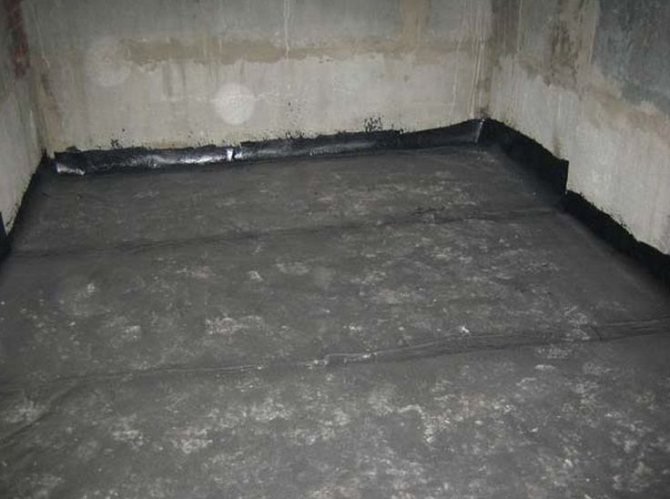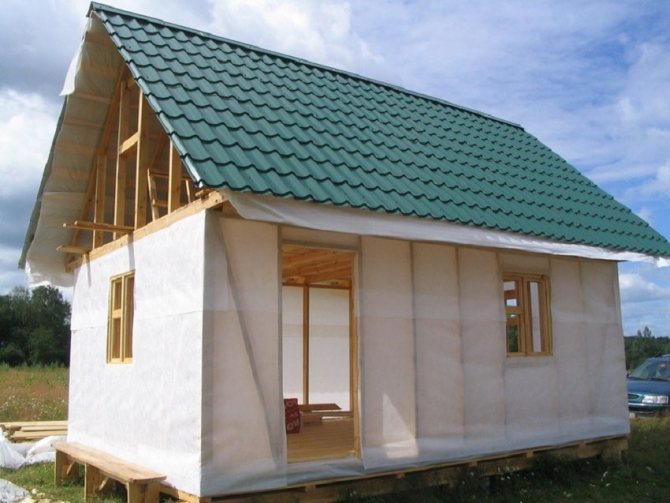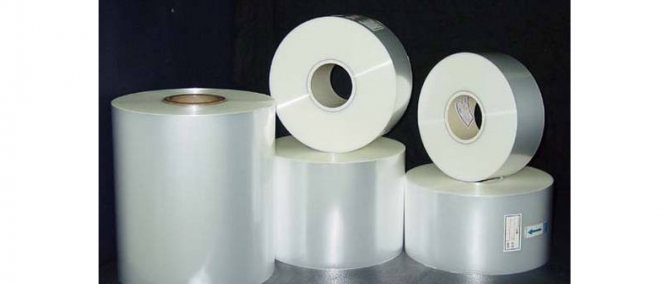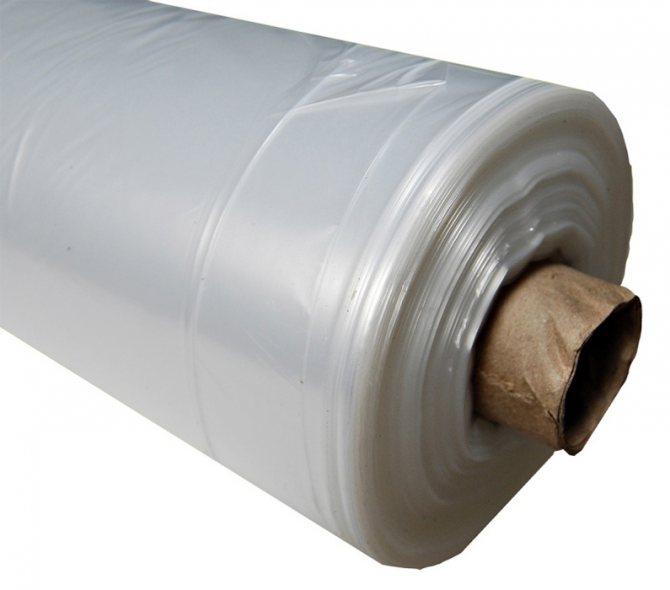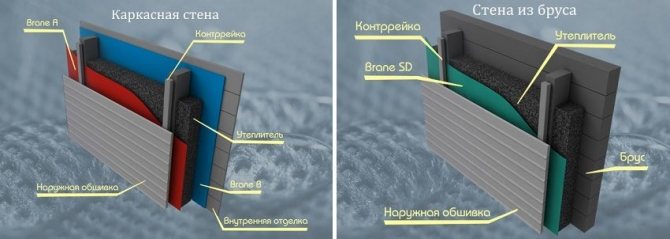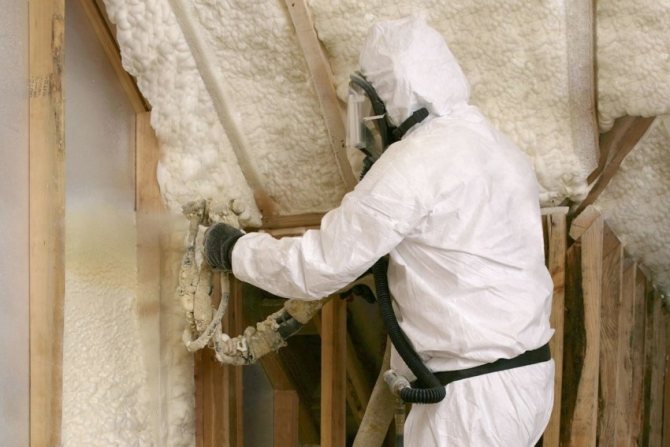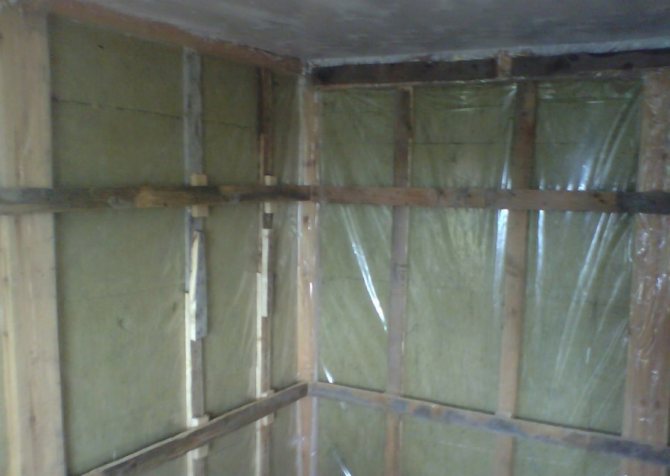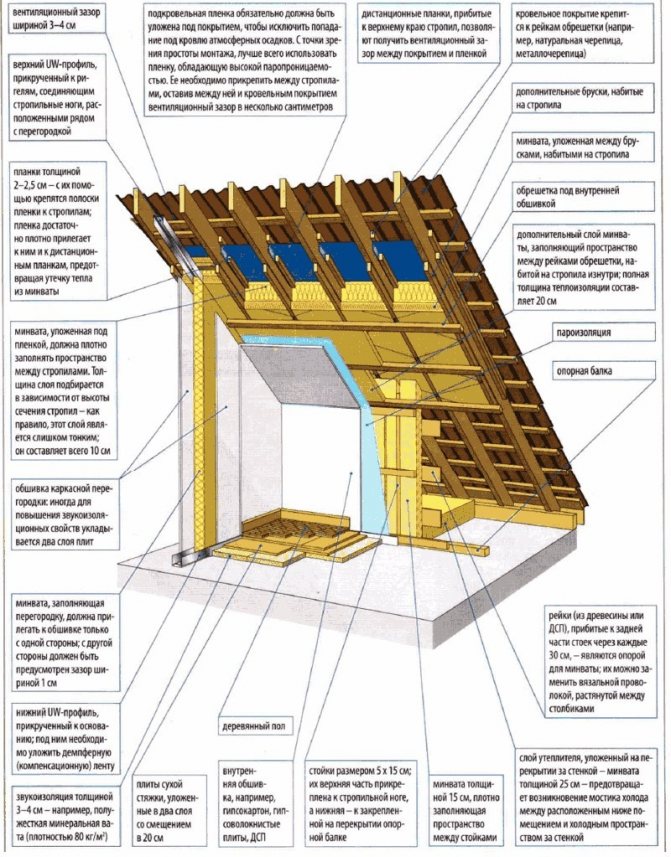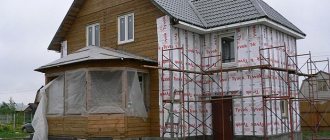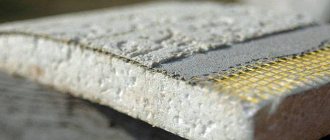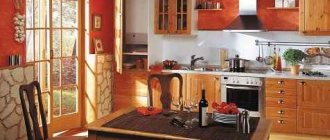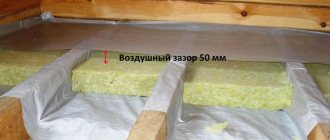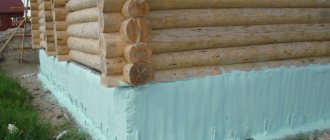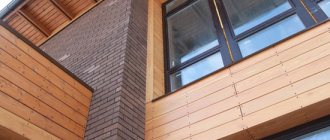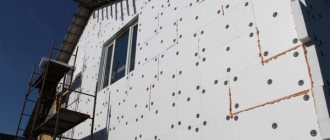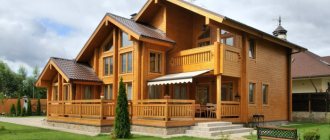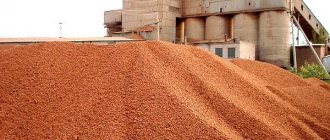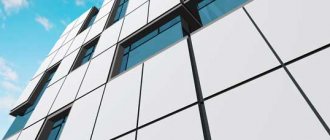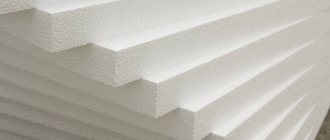Insulation and vapor barrier of walls from inside a brick house
The heat transfer properties of brick walls tend to deteriorate over time. The fact is that from the inside of the masonry, between the rows of bricks, heaters are usually laid - mineral or glass wool, which, under the influence of penetrating moisture, gradually lose their properties. The insulation can be changed, but this requires disassembling the outer layer of the brick, removing the insulation from the inside and replacing it, and this is a very expensive and time-consuming measure... In addition, over time, the properties of the brick itself deteriorate.
In this case, it is necessary to produce external or internal insulation of the wall. When choosing between these two types of insulation, preference is given to external insulation. At the same time, there are situations when external wall insulation is impossible or impractical - as in the case of insulation of an apartment in an apartment building or insulation of a building of historical value, etc.
Cons of insulation inside a brick house
- insulation from the inside of the house does not protect the wall from destructive climatic factors;
- it is less efficient in terms of heat conservation;
- hides the useful internal volume;
- creates high humidity between the insulation and the inside of the wall of the house. Condensation forms, which leads to the gradual destruction of the wall from the inside. In addition, this leads to the formation of a favorable environment for the reproduction of molds, which not only accelerate the process of destruction of materials, but also have allergenic properties and are simply harmful to residents.
To eliminate this type of shortcomings, builders use methods that postpone the dew point (creating an air gap), vapor barrier and special antifungal compounds.
Warming methods
Warming with plaster
Features of the
This is the "dirtiest" method of insulation from the inside, coupled with the need to completely empty the room. At the same time, it is one of the most inexpensive and easiest to implement. It takes a lot of time and effort.
Technology
- Wall surface preparation. Cleaning from wallpaper, paint, plaster.
- Installation of slats up to 5 mm thick on the wall (interlayer between the wall and the mesh).
- Reinforcement of the surface with mesh up to 50 mm.
- Sequential application of plaster layers with a total thickness of up to 10 cm.
Thermal insulation with foam or expanded polystyrene
Features of the
One of the best methods of insulation from the inside of the house. It allows you to significantly enhance not only thermal insulation, but also noise insulation in a brick house. Expanded polystyrene has better performance than polystyrene, but is more expensive.
Technology:
- Cleaning the wall surface from wallpaper, paint, old plaster.
- Leveling the surface of the walls.
- Application of a layer of antifungal agent, primer.
- If the wall is being prepared for drywall, then the installation of brackets.
- Fastening panels to the wall - using glue or special dowels in the shape of a mushroom.
- If the wall is being prepared for wallpaper or painting, installing a reinforcing mesh followed by plastering the surface.
- If the wall is being prepared for drywall - assembly of the drywall wall, jointing, alignment.
- Next, painting or wallpapering is done.
- In case of significant humidity, a vapor barrier is installed.
Insulation of a brick wall with penofol
Features of the
Penofol is a material consisting of several layers, including foil. It is only advisable to insulate them only for premises that are used exclusively in the warm season (cottage, barn, etc.).
In other cases, this material is used as an additional heat-insulating layer and vapor barrier (with mineral wool). Aluminum included in the composition of the material requires the implementation of increased electrical safety measures.
Technology
- Preparing the wall.
- Treatment with anti-mold compounds.
- Fastening of 20 mm bars to provide an air gap.
- With the help of a construction stapler, sheets of penofol are attached to the beams.
- Glue the joints of the sheets with aluminum tape.
- On top of penofol, another layer of bars is strengthened.
- Drilling of sheets of gypsum board, fiberboard, chipboard or other selected material.
- Wall surface preparation, wallpapering or painting.
Penofol can be glued directly to the wall with glue. But in this case, thermal insulation and vapor protection are reduced.
Insulation of walls from the inside with mineral wool or glass wool
Features of the
Mineral or glass wool is afraid of moisture, so special precautions must be taken with respect to moisture. It is necessary to install slats on the wall to provide an air gap and to keep the dew point away.
They have a soft surface, so it is imperative to mount some kind of rigid structure, be it drywall, fiberboard, chipboard or something else (it will not hold the plaster or wallpaper on itself).
Technology
- Cleaning the surface of the walls from old layers of paint, wallpaper, plaster.
- Priming the wall and covering it with antifungal agents.
- Installation of vertical slats to provide a gap (the step should be narrower than the thickness of the mats).
- A vapor barrier is installed on top of the rails.
- Installation of frame profiles. The dimensions of the sections should be slightly narrower than the dimensions of the mats or sheets of thermal insulation (for tight contact).
- Filling sections with sheets or mats of heat-insulating materials.
- A vapor barrier is installed on top (protection from moisture from the side of the room).
- Fastening to the profile of sheets of gypsum board or other final surfaces.
- The final stage is preparation for wallpapering or painting the wall (if necessary).
Thermal insulation with liquid products
Features of the
Thermal insulation of the wall with liquid sprayed agents is rarely used, as it requires special equipment and trained personnel.
It is the most expensive of the listed methods.
It is produced by spraying special compounds (polyurethane foam). When applying the method, a vapor barrier is usually not required.
Technology
- Surface cleaning and priming.
- Building a profile from beams or a metal profile.
- Filling the sections with polyurethane foam.
- Undercutting of spraying defects.
- Finish coating.
What materials are used for basement insulation?
Many experts say that basement insulation will help to avoid many problems that almost always appear when using wooden houses. It is also noted that the temperature of the floor in the house is directly related to the level of heat in all rooms of the structure.
To keep the basement warm, you can use both traditional and modern thermal insulation materials:
- Mineral wool.
- Penoizol.
- Styrofoam.
- Expanded polystyrene.
- Polyurethane foam.
- Penoplex.
- Penofthol.
Mineral wool is a traditional, familiar natural insulation material that can also be used to insulate ceilings from the basement side. It is produced using high-temperature melt technology. Despite the distribution and popularity of the material, it is significantly inferior to modern insulation in all respects.
Mineral wool is sold in rolls and slabs.
Expanded polystyrene is a modern insulation.A high-tech thermal insulation material capable of insulating not only the floors and walls of the basement, but also any other room in any type of structure.
Expanded polystyrene is similar to polystyrene, but has slightly different properties.
Penoftol is a heat-insulating material that does not react with building materials, resistant to biological effects. It has good waterproofing characteristics and minimal thermal conductivity.
Penofthol is foil-clad.
Penoizol is the so-called "liquid foam". The material is non-combustible, resistant from a biological point of view, and boasts excellent thermal insulation and vapor-permeable properties. Long lasting.
Penoizol - insulation and sealant.
Penoplex - modern thermal insulation boards made of expanded polystyrene. They have increased thermal insulation characteristics, relative strength, resistance to biological effects, and minimal water absorption.
Vapor barrier for walls of a wooden, brick or frame house
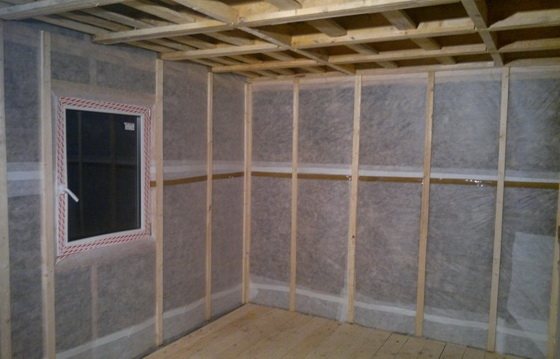
When building all types of houses, various heat-preserving materials are used, but their effectiveness will noticeably decrease if they are not protected by a vapor barrier. To ensure that your house is always dry and warm, in order to exclude the slightest possibility of condensation and the appearance of mold or mildew, you need a competent and reliable vapor barrier for the walls of a wooden house, as well as houses built from other materials.
Vapor barrier work can be performed from the outside or from the inside of the house. The choice of the best option for each specific house depends on the area of the building, the building material and the structure of the building. So, for example, the presence of a veranda around the house can be considered as an air gap that reduces heat loss, and brick walls are known for their high heat transfer, therefore, they require more thorough protection.
Related article: How to sheathe a wall with a laminate with your own hands
A large number of modern, easy-to-use and reliable vapor barrier materials allow you to extend the service life of the insulating layer, create an acceptable microclimate in the house, reduce heat loss and increase energy savings. It is worth noting that each type of house has its own specific features for performing this operation.
Types of vapor barrier materials
- Glassine and roofing felt. Traditional materials are sometimes used today. Fastened to the flooring of boards or OSB boards.
- Reinforced polyethylene films. Used as vapor barrier in saunas, swimming pools and bathrooms.
- Reinforced polypropylene films, plain and with an anti-condensation viscose layer. It absorbs moisture, preventing condensation. With the onset of the warm season, moisture evaporates. These films are durable and not expensive.
- Membranes are diffusion or breathable. The most promising view, allows the insulation to "breathe", does not allow moisture to penetrate to it from the inside. Does not require air gaps, can be single or double-sided.
- Special materials: reflective films with aluminum coating, foamed polyethylene with aluminum foil - penofol.
A wide range of such materials allows you to choose the right one at the best price. But the best do it yourself vapor barrier - using modern films.
Features of the vapor barrier of the walls of a brick house
Brick continues to be the most popular material for the construction of country houses. To reduce heat loss, brick walls need to be intensively insulated on the outer surface of the building or from the inside of the house.
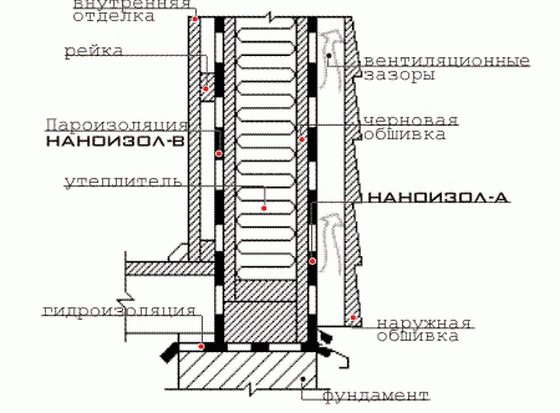

Insulation work must be accompanied by the installation of a vapor barrier layer.When insulating the outer wall of the house, it is best to lay the layer on both sides of the insulation, which will ensure complete tightness. A good vapor barrier for the walls of a brick house will create a solid barrier to rain, wind and noise. When laying a vapor barrier, it is necessary to leave gaps for ventilation, carefully connect all joints of the material.
If, for some reason, the external cladding does not cope with its functions or the walls are of a small thickness, then in order to avoid the appearance of condensation on the surface of the walls, you can additionally perform vapor barrier cladding inside the room.
Outside
We start work only after 4-5 years and with the complete shrinkage of the building. It is recommended to install the vapor barrier on a bare timber before the insulation. Installation on a building from a bar is carried out in the following order:
- On the timber - a vapor barrier, fixed with slats;
- Lathing;
- Insulation;
- Waterproofing;
If your building is made of chopped wood, then the protective film can also be installed on the surface of the finished wall. Ventilation is carried out due to gaps in the material. The frame building is vapor-insulated in the same way as the timber one.
The device of a vapor barrier layer in frame houses
In the construction of frame-type houses, boards of small width are used, which requires the use of a high-quality insulation layer. So that you do not have to carry out work on its replacement soon, it is necessary to protect the layer from steam, which is oversaturated in the air of any living room.
Vapor barrier for the walls of a frame house is carried out only from the inside of the building. When laying sheets of film or membrane, it is necessary to ensure that there is a ventilation gap between the heat and vapor insulating layers and absolute tightness. In places where it is necessary to make holes for sockets, switches or other elements of the engineering equipment of the house, the vapor barrier material must be glued with self-adhesive tapes or sealant. The sheets of material should be placed on the walls not vertically, but horizontally, laying each subsequent layer with an overlap of 10-15 cm and providing a slight sagging of the film.
The vapor barrier is attached to the frame posts with a stapler. The more carefully you do this work, the less likely there will be breaks and damage that will break the tightness.
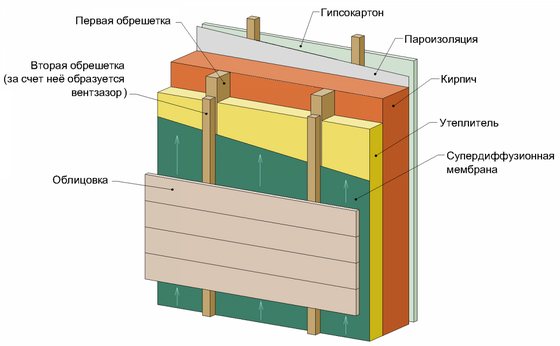

Floor insulation technology above the basement
With any method of insulation, waterproofing is first laid. In this capacity, ordinary plastic wrap is suitable. The adjacent strips are overlapped and fixed with mounting tape. Necessarily need an overlap on the walls. Its height depends on the thickness of the cake, including the screed, if any.
You can use PVC film as a material for waterproofing.
Further installation depends on the type of insulation and base:
1. On a flat base, the insulation slabs are laid out end-to-end on the floor, connected with tape.
2. When laying on wooden logs, the slabs are placed between the logs by a strap, fixation is not required.
3. When pouring the screed, put another layer of waterproofing on top.
4. When installing underfloor heating under pipes / cables, a layer of foil is placed on top of the insulation, which reflects all the heat from the system into the room.
5. It is most convenient to place loose materials between the logs and close them on top with subfloor boards: this way they do not reduce the height of the room. When mounted on a flat base, instead of lags, wooden partitions are installed, on which the subfloor boards will then rest.
6. Before pouring the screed, a waterproofing membrane (preferably PVC) must be laid on top of the expanded clay. The screed is poured over the lighthouses and leveled with the rule.
7. When installing the screed on top of the underfloor heating system, it is necessary to lay a damper tape around the perimeter of the room, otherwise the concrete will crack when heated.
eight.The composition of the sawdust mixture: 85% sawdust, 5 - gypsum, 10 - lime. The components are mixed dry, then diluted with water. The recommended layer is 25 centimeters.
Sawdust screed is not used for underfloor heating. It should be fenced off from the furnace with refractory bricks.
The top coating can be anything: planed boards, linoleum, parquet, laminate, ceramic tiles. Some of them require a solid base. In the absence of a screed, sheets of chipboard or fiberboard can be used in this capacity.
Protection of walls of wooden houses
Eco-friendly houses made from natural wood require thorough protection from moisture that causes rotting and deterioration of this material. The vapor barrier for the walls of a wooden house from the outside should not adjoin directly to the wood, because in order to create high-quality ventilation, a crate should be made on which the vapor barrier material will be attached (from above it is covered with insulation, on top of which the cladding is performed).
The vapor barrier for the walls of a wooden house from the inside works much more efficiently. Before arranging it, it is necessary to prepare the surface of the walls. Wooden walls usually have cracks that are clogged with dust and dirt. The walls must be leveled, all voids must be repaired and the surface treated with an antiseptic. Only then can you begin installation work on laying the vapor barrier material and insulation. For wooden walls, it is best to choose a film coating or a membrane-type vapor barrier, which will not adversely affect the condition of the wood.
When you can't do without a vapor barrier
Of course, deciding whether a vapor barrier is needed for drywall is solely a matter for the owner of an apartment or a private house. But there are situations when a vapor barrier material is required for a full repair. These are:
- Cases when a layer of mineral materials for insulation is placed in the frame structure, which are located in close proximity to the street.

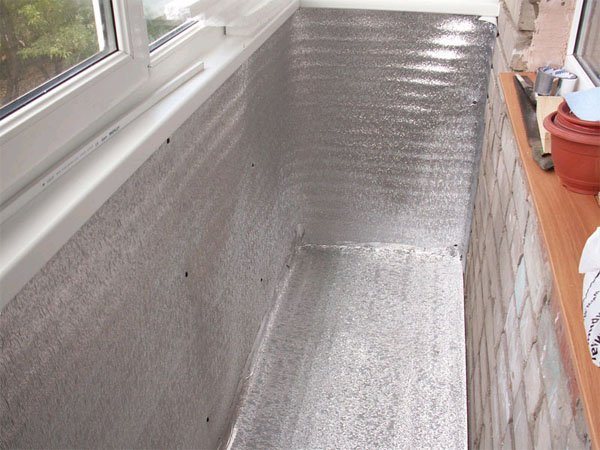
Using foil vapor barrier on the balcony under drywall - If several layers of insulating materials are laid under the drywall sheets in the frame. For example, a heat-insulating layer and basalt. In this case, it is imperative to install a vapor barrier material into the structure of the crate in order to preserve all the properties of other insulating sheets.

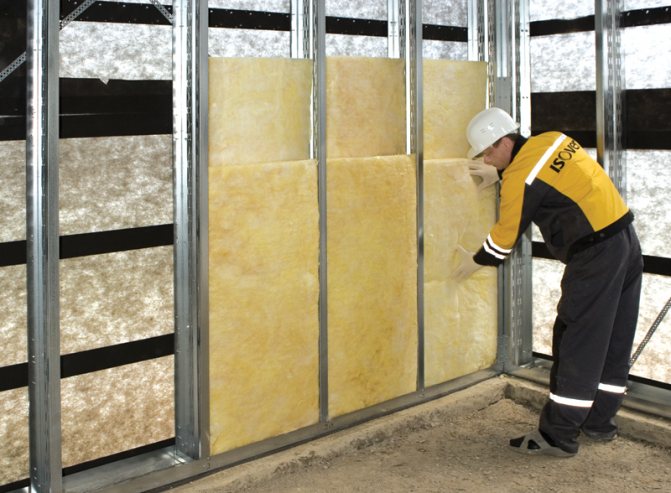
Insulating material laid in two layers in a frame for plasterboard - And also a vapor barrier material will be needed if the room is corner. By installing a vapor barrier film, the room is protected from wind gusts and cooling of the plasterboard floor.

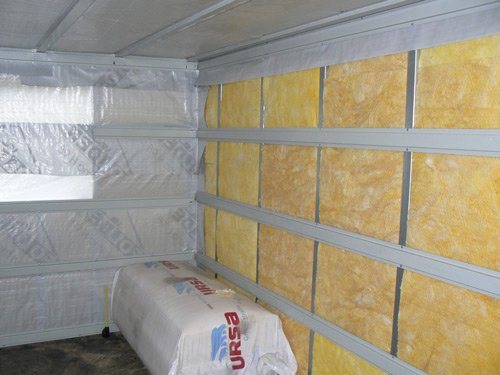
An example of an insulated corner room with heat-insulating film and insulation
Based on the foregoing, we can conclude that a vapor barrier material is necessary in order for the repair process and its result to fully satisfy the wishes and expectations of the owner of the property.
The process of vapor barrier walls from the inside
The main task in the construction of any building is to protect the entire structure from the direct effects of moisture. It is so destructive that it can destroy any building material. In addition to moisture, another serious enemy is known, it is steam.
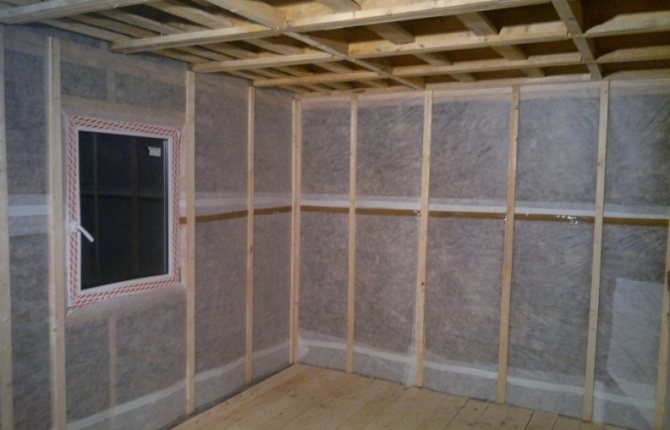

When building houses, it is important to vapor barrier the house from the inside. This is due to the fact that moisture destroys any material over time.
If you neglect the protection from the resulting steam, mold, fungus will appear on the surface of the walls, and dampness will appear. That is why every house requires a vapor barrier from the inside.
Ceilings vapor barrier
When vapor barrier ceilings, the protective material is laid both outside the building and inside.
For external insulation, several protective layers are used. Two layers of vapor barrier and one thermal insulation form a "pie" that reliably protects the wood and the room's microclimate
It can be omitted if the main building material is timber.This type of wood perfectly absorbs moisture and does not need additional protection.
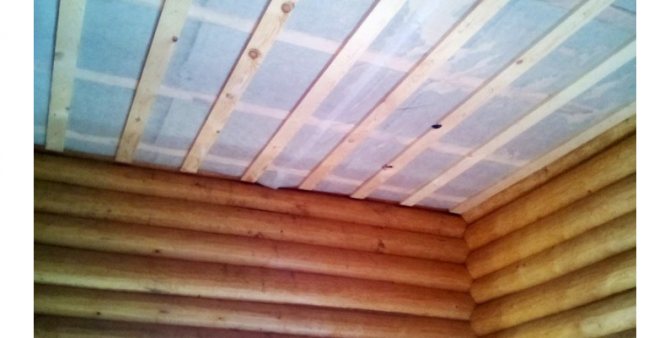

Laying the film
For the vapor barrier of the ceiling of the suburban frame house, the same materials are used as for the floor. The difference lies only in the approach to implementation. So, the organization of protection from steam on the ceiling in a wooden house requires taking into account structural features and secondary factors, for example:
- The type of premises in which thermal insulation is carried out.
- The presence of living rooms on a higher level.
- A vapor barrier is made for an unheated house or for a house with heating and many other factors that need to be consulted with specialists.
For more information - call us! We will answer all your questions, tell you which vapor barrier to choose for a frame house, and give detailed advice on carrying out this type of work.
Some features
It is simply necessary in damp and at the same time warm rooms. A prime example would be a sauna, possibly a heated basement. Such rooms are located underground, they are most exposed to attacks of dampness.
Due to the fact that steam and humidity are present in huge quantities in the sauna, this room must be vaporized.
In such rooms, steam is always generated in the form of warm air, with a huge amount of the smallest droplets of water. The resulting steam simply needs to find a way out of such a room. He looks for ways and finds them in the form of the walls of the building, its ceiling.
In this case, the formation of steam becomes permanent, the destruction of building structures occurs, the building becomes emergency. To protect the walls of the building, a special vapor barrier is made, which prevents steam from entering from the inside, as a result, the life of the walls and partitions is extended.
Installation of vapor barrier is not limited only to baths and basements. It is also necessary to install vapor barrier of internal walls in buildings that have external insulation, when the walls are of a homogeneous material.
I must say that there is no special vapor barrier material that is suitable for all rooms in the same way. The type of vapor barrier depends on the existing structural component of the internal wall structures.
Inside
Internal vapor barrier is essential for life, so it is done immediately. The process is very simple in words: a heater is installed on the timber, and on it, in turn, a vapor barrier. The material must be properly tensioned so that there is no sagging. You can fix it not only with a construction stapler, but also with ordinary nails with a wide hat. Since the vapor barrier is usually mounted in strips, it is necessary to overlap it (2-3 cm is enough) so that there are no areas without protection. In wet rooms, the procedure must be carried out with special care. After installing the protective film, drywall is usually installed. It is important to remember that wooden structures are very specific and the best way out of possible problems is to consult a specialist.
There must be at least 0.3 cm of free space between the final coating and the insulation so that air can circulate freely and moisture can dry out.
Situations when it is necessary to install an internal vapor barrier for walls?
The vapor barrier of the walls must be done in several cases.
Mineral wool is a breathable material, however, with this type of insulation, a vapor barrier is simply necessary.
- If the walls have installed internal insulation. Moreover, mineral wool was used as a material for thermal insulation. Excellent thermal insulation properties are shown by mineral wool from the group of "breathable materials". But it has one negative property, mineral wool is not friendly with moisture. It gets wet quickly, gradually its properties deteriorate, it begins to deteriorate quickly. To prevent such cases from happening, vapor barrier of the walls is used from the inside of the building.Frame houses with wall structures consisting of several layers must certainly include a vapor barrier material. This also applies to structures with internal insulation.
- A powerful windproof function for buildings with a ventilated facade is performed by the laid vapor barrier layer. It measures and softens the air flow. As a result, the outer insulation is less overloaded, it acquires free "breathing". For example, a wall made of bricks, which has external insulation, made of mineral wool heat insulator and upholstered with siding. In this case, the vapor barrier becomes a kind of wind barrier, it reliably protects the walls of the building from powerful blowing. The existing ventilation gap removes excess moisture from the installed windbreak.
- In order to provide a good microclimate in the room, it is necessary, together with the vapor barrier, to install effective and reliable ventilation operating in a constant mode.
Related article: How to decorate the walls in the hallway
We will apply knowledge in practice
And now, without delay, let's try to apply our knowledge in practice. Here's how some builders recommend dealing with a log house. One of the methods of insulating it is the following. It is recommended to cover the blockhouse with bricks. And so as not to dampen, the walls outside are finished with glassine. For those who are not in the know, we inform you that this is a vapor barrier (waterproofing) film. That is, its resistance is less than that of polyethylene, but more than that of many other building materials. What actually happens in this case?
In the cold season, the house will be damp from the inside. In the process described above, moisture will rush out. The permeability of wood is quite high. But having overcome the barrier in the form of a wall, the steam will rest against the glassine. Due to the low temperature existing outside, all the liquid will fall out in the form of condensation. She will have nowhere to go, because glassine interferes with evaporation. As a result, the entire wall will become damp. Then, when frost hits, the wood will suffer serious losses from the resulting ice. The content of moisture in the heat-insulating material in the amount of five percent by weight reduces the heat-insulating properties by 40 percent.
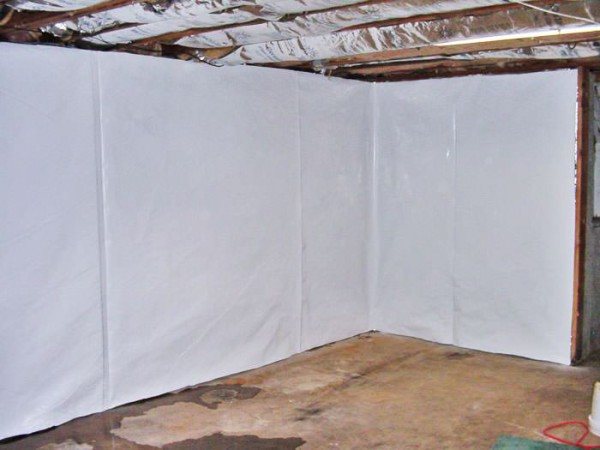

Wall insulation
Based on the foregoing, we can conclude that the hut will be not only damp, but also cold. In the meantime, we begin our discussion with the idea of improving the characteristics of the house. It is clear that not every beginner can immediately start thinking in construction categories. Therefore, to facilitate the assessment of the feasibility of a particular action, it is recommended to use special programs for the calculation. An example of such a calculator can be found at https://smartcalc.ru/thermocalc?&gp=212&rt=0&ct=0&os=0&ti=20&to=-27&hi=55&ho=80&ld0=10&le0=1<0=0&mm0=606&ld1=2000&le1=1<1 230
Submitting your data for the calculation, you can make sure that the external vapor barrier of the walls in the cold season will only aggravate the situation. For example, let's take a log house with 20 cm transverse logs. In the winter cold, when the room temperature is normal, the wall gets damp. If you overlay everything with bricks, then it practically does not change the picture. But the vapor barrier membrane, laid between them, exacerbates the situation. Moreover, the brickwork also begins to dampen.
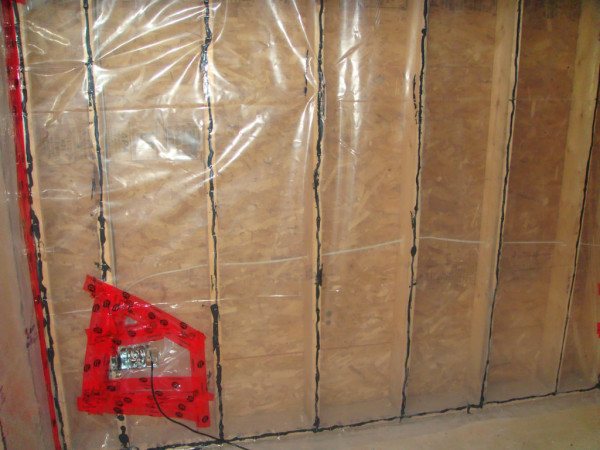

Recommended: How to glue tiles to the floor: tips for choosing tiles and how to properly glue them to the floor
Vapor barrier with wire outlet
Using the same program, you can find the correct solution to the problem. To begin with, we will calculate the heat loss of our log house in order to understand whether it is required to carry out thermal insulation work. For example, let's take a square house with an area of 100 square meters with a ceiling height of 2.5 meters. Using the heat transfer resistance of our wall (taken from the program), we find the desired value:
N = 10 x 2.5 x 4 x (20 + 27) / 1.27 = 3.7 kW = 37 W / sq. m.
By all indications, this blockhouse does not need insulation. The losses are 37 watts per square meter. This is a perfectly acceptable figure for the latitude of Moscow. Now let's see how the walls need to be finished from the inside in order to exclude the occurrence of a dew point. It turns out that it is enough to put a vapor barrier membrane in one layer so that the conditions for condensation are violated. This is a typical example of how a problem can be solved with a simple step. The vapor barrier of the walls from the inside in one layer blocked the conditions for the formation of condensation.
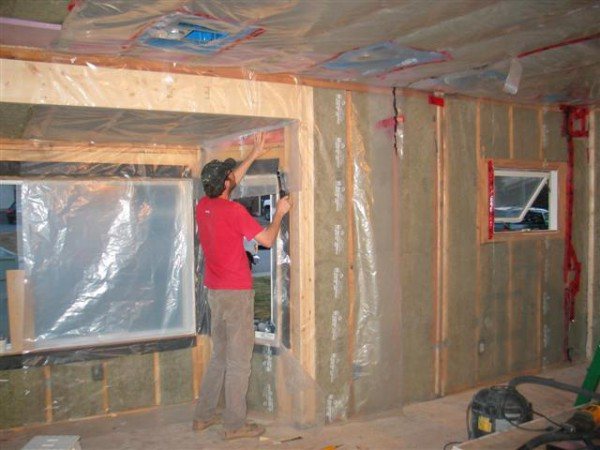

Conducting vapor barrier
What materials do builders use today for laying a vapor barrier?
The scheme of the vapor barrier.
However, the expression "vapor barrier walls" does not mean that such a protective barrier does not allow any vapor to pass through. Membrane materials used by builders today are endowed with the ability to pass a certain amount of air flow. This is done for one purpose only.
There should be no “greenhouse effect” in the room. The installed membrane retains excess moisture that has passed through it; it will not be able to negatively affect the internal walls of the house and the installed insulation material. When the insulation has an inner "coat", then the flow of the wet mass through the exhaust ventilation takes place.
Varieties of vapor barrier materials
Polyethylene is a classic vapor barrier material. This material requires careful handling, because if the film is pulled tightly, it can break at the time of changing climatic conditions. But there is one very important condition. Polyethylene must be perforated, otherwise it will not let in, in addition to steam, also air. It will not be possible to get a comfortable microclimate in the building with such a film. If this polyethylene is used as a membrane, it will interfere with the flow of air mass, it cannot be used for vapor barrier.
The scheme of the vapor barrier of the walls from the inside.
You can make the perforation of the plastic film with a special device. Take a roller with hammered nails. Such a "modernization" of the polyethylene film will not be able to provide reliable vapor barrier for internal walls. Of course, membrane materials are very similar to plastic wrap, but they differ greatly from it in their multilayer structure.
Builders often use special mastics as vapor barrier materials. After application, such a mastic is capable of allowing air to pass through, while retaining moisture. Surface treatment with such mastic begins to be done before finishing.
Membrane films have become a modern material that is used today for laying a vapor barrier.
This material is able to prevent the ingress of moisture, and at the same time to let the air flow through. Such membranes have a certain vapor permeability, which ensures the normal operation of the insulation. When such a vapor barrier is installed, the cotton insulation does not get wet, the walls "breathe", there is no freezing.
Orientation of vapor barrier material
All of these jobs do not require special qualifications, but sometimes do it yourself vapor barrier performed in violation of the manufacturer's instructions for the material. If the film on both sides has the same structure and color, then both sides are considered to be working.
When the sides are different, the installation requirements must be carefully examined. Rule, which side to lay the vapor barrier, in general: if the film has a smooth and rough surface, then the rough side - it is she who will retain moisture - is located outside, and the smooth side is towards the insulation. The reflective surfaces of the film always look outward: their smooth side faces the insulation.
Nuances of vapor barrier walls installed from the inside in a wooden house
When freezing of the wall is detected, the wall is insulated around the entire perimeter, from the inside. If wet spots are formed due to freezing, the wall is insulated from the inside with so-called warm plaster.
The vapor barrier is placed on a woven mesh.
- Typically, the applied layer does not exceed 30 mm. It is placed on a special woven mesh. As a result, a reliable adhesion of a special heat-insulating plaster to the wall is ensured. Craftsmen recommend insulating the interior walls entirely in one room.
- As a result of such actions, moisture will not be able to spread beyond the boundaries of the damaged surface. When insulating the walls inside the building, it is necessary to make such a vapor barrier, which will reliably isolate the repaired area from wet vapors of air flows.
- Before you start to insulate the walls with a special solution, you must first remove the previously applied plaster. If you do not do this and put a new layer on the remaining plaster, then in order to obtain reliable adhesion of the plaster to the surface, you need to mount the reinforcement cage and fix it. Pull the mesh onto the frame and only then plaster the wall with the prepared heat-insulating mortar.
In recent years, builders have been using woven mesh. This material adheres tightly to the surface, the adhesion to the partitions and the wall of the room increases, the required roughness is formed.
Plastering the surface is carried out in several steps. First, a spray is made, having a continuous layer with a thickness of 9 mm. Spraying is performed with a liquid solution that has the ability to flow into any pores of the surface. It adheres firmly to the surface. Then the surface is primed to level out the remaining irregularities.
Requirements for vapor protection
- The vapor barrier layer must meet the following requirements.
- Provide the calculated resistance to vapor permeation with a thickness of not more than 4 mm.
- Have heat resistance, excluding "creep" of the material on vertical surfaces at temperatures up to 50 ° C.
- When exposed to positive and negative temperatures, maintain the calculated resistance to vapor permeation and adhesion to connecting tapes or insulated surfaces.
- Maintain elasticity, be continuous and vapor tight at joints.
The material must have installation instructions.
Wall vapor barrier: purpose, application, types and methods of their installation
No matter how dry the air inside the room may seem, it contains a considerable amount of moisture vapor. And no one would have paid attention to them if energy-saving technologies had not been used in modern construction. Insulation (or rather the heaters themselves) turned out to be defenseless against moisture and vapors, since getting wet, they lose their ability to retain heat inside the premises. To protect them, a hydro and vapor barrier is used - the first is installed outside (in most cases it is used to protect insulation from street moisture), and the second from inside the room. The task of the latter is to protect the insulation from water vapor contained in the indoor air of the premises. It is about him that will be discussed in this article, in which, together with the site stroisovety.org, we will deal with the purpose of this material, the types and methods of their use.
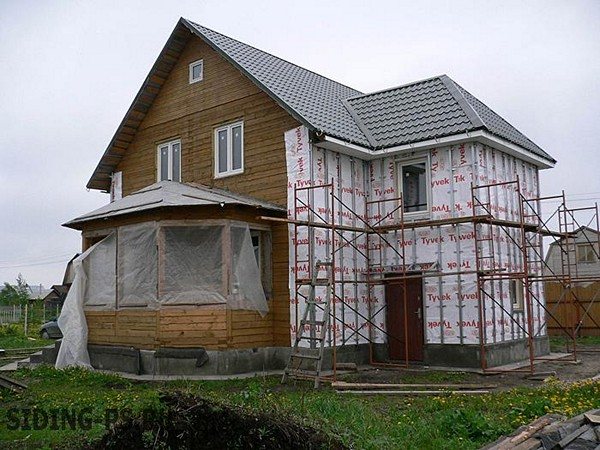

Why do you need vapor barrier walls
Wall vapor barrier: what is it for and when it is impossible to do without it
There is only one correct answer to the question of why wall vapor barrier is needed, which we partially touched upon a little above - at least, this is how it looks in brief. If we consider it more extensively, then we should also touch upon the topic of moisture exchange in rooms, which occurs, regardless of our desire, in an invisible way to us.The moisture in the air, or rather its excess, is absorbed into the walls of a house or apartment, and if there is a lack of water in the air, moisture returns back from the walls. Now judge for yourself - where do you think the excess water vapor will go if you install a heater between them and the wall? Naturally, they will accumulate in it, and then, as described above, fill all the empty space between its fibers and displace air from them, which, in fact, is a heater. It's no secret that water in all its manifestations is by no means such.
Related article: Why walls bloom in a house
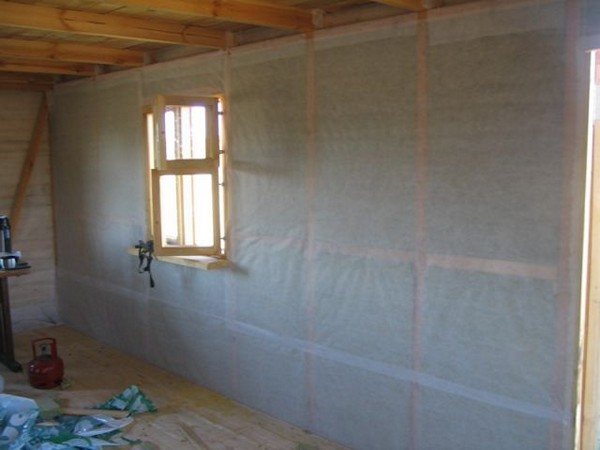

Vapor barrier of walls from the inside
Installation of vapor barrier walls is not necessary in all cases - an important condition for the absorption of moisture vapor by the insulation is the temperature difference, which is largely noticeable on the outer walls. Moisture simply condenses inside the insulation, turning into water droplets - they are the ones that are dangerous for the insulation. If this does not happen, then there is no need to install a vapor barrier - for example, there is no such effect on the inner walls of the house.
In this regard, a number of rules can be formulated when it is impossible to do without the use of vapor barriers.
- Vapor barrier is necessary for thermal insulation of building walls with direct contact with the street with mineral materials.
- Multilayer wall structures, which include mineral, basalt or any other wool, must be covered with a vapor barrier on the inside. The device for vapor barrier of frame walls is no exception - they are also a multilayer structure.
- Ventilated facades. During their installation, mineral wool insulation is generally placed between two protective layers - a hydro-barrier and a vapor barrier. The first, outer layer, protects the insulation on one side, and the inner layer, located from the building wall, plays the role of a vapor barrier. Also, the vapor barrier in such structures additionally performs the function of wind protection. A striking representative of such facades is a house sheathed with siding, with mineral wool insulation placed behind it.
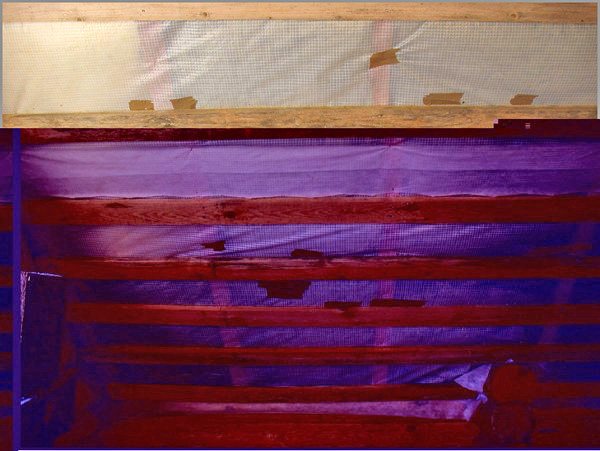

How to attach a vapor barrier to a wall
A very important point accompanying the vapor barrier of walls from the inside and outside is the availability of high-quality ventilation. If we talk about internal vapor barrier, then the internal rooms should be ventilated, if about external vapor barrier, as in the case of siding, then a ventilation gap is needed here. Air passing through it removes excess moisture that settles on the vapor barrier.
Why insulate the floor above the basement?
- The floor above the basement is cold
- Mold and mildew will gradually grow on its surface and on the walls.
The appearance of such troubles leads to:
- To spoilage of the performed repair
- Accelerated structural failure
- Decreases the health of people living in the house
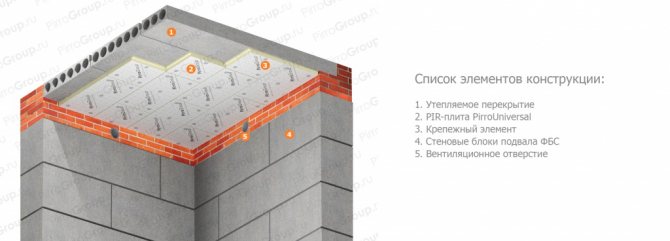

When an unheated basement is planned in a residential building, thermal insulation of the floor above the basement is always necessary. Since, firstly, the walls are not insulated in a cold basement, and the temperature in the basement is negative in winter. A cold floor means uncomfortable indoor conditions and a significant waste of energy resources for heating. And, secondly, the moist soil in the underground throughout the year continuously gives off moisture in the form of water vapor, which is saturated with wooden logs. The surface of the basement ceiling that is not insulated and not protected from moisture will easily transfer cold and dampness to the room, which is located above. The basement microclimate promotes the development of mold and mildew on the walls.

